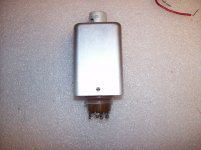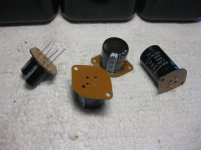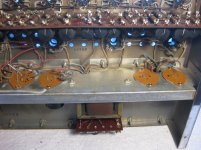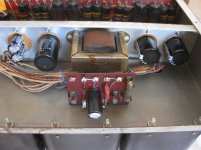I'm working on a little tube amplifier and it had a multi section
cap that was made up of two 40 uf 350 Caps in the same can.
I was going to CNC a mounting plate out of a section of PC Board, but looking at the
hole it looked about the same size as a 8 Pin tube socket. Sure enough it was a good fit.
I removed the excess pins and installed the caps on top and soldered them underneath to the
remaining pins. (I could have kept the excess pins in but they were easy enough to remove).
This what it looks like.

Note: This looks a little different than the original socket because I flattened
the top with a lathe. It wasn't really needed and was mostly cosmetic.
I'm just posting this figuring it may help someone else.
.
cap that was made up of two 40 uf 350 Caps in the same can.
I was going to CNC a mounting plate out of a section of PC Board, but looking at the
hole it looked about the same size as a 8 Pin tube socket. Sure enough it was a good fit.
I removed the excess pins and installed the caps on top and soldered them underneath to the
remaining pins. (I could have kept the excess pins in but they were easy enough to remove).
This what it looks like.

Note: This looks a little different than the original socket because I flattened
the top with a lathe. It wasn't really needed and was mostly cosmetic.
I'm just posting this figuring it may help someone else.
.
Last edited:
Interesting solution to a knotty problem.
"Why bother with jury-rigging anything" Price and availability of said cans in the requisite values.
Andy.
Pages and pages of them!
Capacitors - Multi-Section / Can Type | Antique Electronic Supply
I've used them in "restorations" and they're just fine.
Vector boxes
I found a couple of these boxes last night in a piece of test gear. I was thinking along the lines of this thread. Brilliant. I am looking at a stack of amps for restoration that need multicaps. I would rather do this for a fraction of the price and for exact values I need. I was thinking of restuffing cpas which looks like 0 fun....
It's Jerry-rigging, and AES is expensive.
A1 sells a 50/50 @500VDC for $11.50 but I can get two 47u/450V caps for <$1. I usually just leave the old can in place, clip the ground lead off of it, and tack replacements to the underside.
It all depends on what you want to spend and cosmetic appearances.
When you're dealing with a customer's McIntosh, money's no object.
Perhaps, but then again I don't deal with foolish people like that. Pennywise and pound foolish IMHO.
I've seen and heard them, and IMHO my monoblocs kill it for way less money.
As far as cosmetics, the amp looks all original if you leave the original cap in place and fix it under the chassis instead.
I've seen and heard them, and IMHO my monoblocs kill it for way less money.
As far as cosmetics, the amp looks all original if you leave the original cap in place and fix it under the chassis instead.
While replacement can caps. may be of recent manufacture, the production equipment is "ancient". Modern manufacturing techniques yield better volumetric efficiency, lower ESR, and end user cost savings. A 105o C. rating may be part of the "deal" too.
FWIW, modern multi-section parts are available that can be clamp mounted in the openings previously occupied by can style parts.
FWIW, modern multi-section parts are available that can be clamp mounted in the openings previously occupied by can style parts.
Perhaps, but then again I don't deal with foolish people like that. Pennywise and pound foolish IMHO.
I've seen and heard them, and IMHO my monoblocs kill it for way less money.
As far as cosmetics, the amp looks all original if you leave the original cap in place and fix it under the chassis instead.
I won't disagree with most of what you've stated.
But when you're dealing with customers with specific demands, you must ahere to them.
And in some cases, using the original style of "can cap" is necessary to keep things neat, and actually involves less work.
While replacement can caps. may be of recent manufacture, the production equipment is "ancient". Modern manufacturing techniques yield better volumetric efficiency, lower ESR, and end user cost savings. A 105o C. rating may be part of the "deal" too.
FWIW, modern multi-section parts are available that can be clamp mounted in the openings previously occupied by can style parts.
While Antique supply uses "vintage" production equipment, their products are as reliable as something new.
The equipment is only for the cans, not the "insides", which are modern upgraded materials.
In all the years of dealing with them, I've never had an issue with failures.
I'm just posting this figuring it may help someone else.
.
A nice option for when room is tight underneath. If they could be found small enough to fit on a 9-pin under a shield they'd blend in even more.
When you're dealing with a customer's McIntosh, money's no object.
Obviously budget and customer preference will always play a part but in DIY for yourself a cheaper fix can often make keeping a piece of not so exclusive equipment going worthwhile.
I've used them in "restorations" and they're just fine.
I guess the specs on the originals were the same but I'm not a big fan of the tolerance on the + side "-10%, +50% Tolerance" of the new cans.
I used my cnc to cut the phenolic.
That looks like a Harnan Kardon amp that I restored last year for someone with the Jim McShane kits.
I did, however, have to install some additional modifications that McShane doesn't seem to know about.
I hope you rip those old bumblebee caps out for new caps.
It's Jerry-rigging........
Curious:
"Jury-rigged" vs. "Jerry-rigged" - Everything After Z by Dictionary.com
This anonymous authority says it is "jury-rigged", where "jury" is nautical for "makeshift" or "temporary", and "jerry-built" is a variant.
Wikipedia has a more elaborate explanation:
Jury rigging - Wikipedia
For those wondering why I went this route. ...
Since the amp is enclosed I used high temperature rated caps.I could have made
a mounting plate but the socket fit and the mounting holes lined up. If I ever decide
to put a mult-section cap in it's A simple matter of undoing 2 screws.
When I got the amp the chassis was corroded along with the transformers etc.
So I wound up stripping it and replacing all the caps and resistors and went with
high temp caps, low ESR caps, and 1% resistors. A high temp multi section cap
along with shipping would have cost more than most of the other parts combined.
If I ever sell of give it away it's a easy matter for the next person to put one in if desired.
Since the amp is enclosed I used high temperature rated caps.I could have made
a mounting plate but the socket fit and the mounting holes lined up. If I ever decide
to put a mult-section cap in it's A simple matter of undoing 2 screws.
When I got the amp the chassis was corroded along with the transformers etc.
So I wound up stripping it and replacing all the caps and resistors and went with
high temp caps, low ESR caps, and 1% resistors. A high temp multi section cap
along with shipping would have cost more than most of the other parts combined.
If I ever sell of give it away it's a easy matter for the next person to put one in if desired.
Last edited:
Curious:
"Jury-rigged" vs. "Jerry-rigged" - Everything After Z by Dictionary.com
This anonymous authority says it is "jury-rigged", where "jury" is nautical for "makeshift" or "temporary", and "jerry-built" is a variant.
Wikipedia has a more elaborate explanation:
Jury rigging - Wikipedia
Good to know. To me, Jury-rigging is the rigging of a jury to achieve the verdict you would like.
- Status
- This old topic is closed. If you want to reopen this topic, contact a moderator using the "Report Post" button.
- Home
- Amplifiers
- Tubes / Valves
- A different way of replacing multi-sectional Caps with regular ones.




